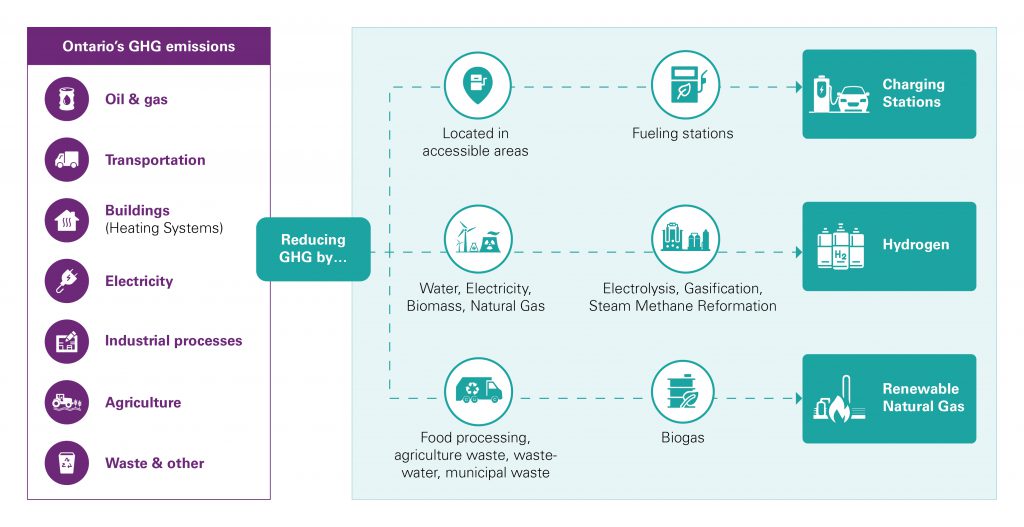Ontario is a proud leader in clean electricity. We began the twentieth century by harnessing Niagara Falls to produce low-cost green power and, early in the twenty-first century, became the first province or state in North America to eliminate the use of coal for electricity generation. When it comes to environmental sustainability, while others have dragged their feet and made excuses, Ontario has punched above its weight.
There can be no doubt that this leadership — in combination with the corporate social responsibility of our companies and the individual choices of millions of Ontarians — buttressed our economic competitiveness in the past and is non-negotiable for our future success. Climate change is real and will affect Ontario’s economy as significantly as COVID-19.
Ontario currently has a head start on other jurisdictions with 96% of our electricity produced from emissions-free sources. Unfortunately, power generation isn’t the only source of greenhouse gas (GHG) emissions in Ontario. Ninety-seven percent of emissions now come from other sources. And Ontario is at risk of falling behind when it comes to reducing emissions from these other sources, which include transportation & logistics, agriculture, heating, and the manufacturing of construction materials.
Low-emissions electricity will be an important strategy for reducing emissions from light duty vehicles. Our auto manufacturers, with support from the Province and Government of Canada, are making significant investments to support manufacturing of electric vehicles. However, as of mid-2019, there were only 980 public charging stations and only 2,700 electric vehicle public charging ports across Ontario. In order to achieve wide use of light duty electric vehicles, Ontario has all of the technology available but needs to champion a project to roll out the required charging infrastructure for light vehicle electrification across major highways, government buildings, rest stops and streets. This is the precursor to shifting demand, reducing emissions and driving economic development.

While providing opportunities for electric vehicle charging is an ideal solution for personal vehicles, this option doesn’t overcome the hurdle of reducing emissions from the remainder of the economy. Heavy transportation, industrial processes and heating systems represent high-emitting sources. Reducing emissions in these areas is not going to come easily but will require transformational change. Solutions like renewable natural gas and hydrogen, or a combination of the two, are leading candidates for mitigating these other emissions. It’s also a perfect fit for Ontario’s innovation economy, which boasts some of the world’s leading scientists, engineers and energy professionals.
Renewable natural gas is a potentially cost-effective energy alternative that can support peak energy demands on Ontario’s coldest days, when the electricity system would have difficulty replacing current natural gas consumption. Biogas collected from landfills, livestock operations and wastewater treatment plants and that might otherwise be released into the atmosphere can be collected and purified into renewable natural gas. Producers may be able to use the renewable natural gas as their own energy source or sell it to the natural gas distribution grid. Either way, this strategy can help businesses build their economic competitiveness across the Province, while creating more local jobs, optimizing Ontario’s existing pipeline infrastructure and helping to reduce emissions in those toughest industries.
Hydrogen could also play an important role in decarbonizing those end-uses that are not suitable for electrification. Hydrogen applications can provide wide benefits such as little to no greenhouse gas emissions, creation of jobs through research and development and manufacturing, attraction of investment and providing export opportunities to help improve the province’s trade balance. While the future of wide-spread hydrogen use may be decades away, there are steps to be taken today to ease the transition. Numerous pilot projects have been proposed by the private sector, including one by Enbridge Gas to blend hydrogen into the natural gas pipeline. Strategies are also being explored by various levels of government. OREA supports the in-depth exploration of these opportunities. This will ensure that Ontario is prepared with infrastructure projects that can support initial processing, future fueling and distribution facilities, and the testing of potential new end-use applications.
Ontario has an opportunity to partner with the private sector, the Government of Canada and other provinces and states to support its energy transition through broad applications that provide sustainable energy solutions. This will generate high-paying jobs, foster innovation and accelerate the industry. Clean energy solutions have a lot of potential for wide applications within Ontario. Support for clean energy solutions from the Province will help strengthen Ontario’s role as an innovative leader.








